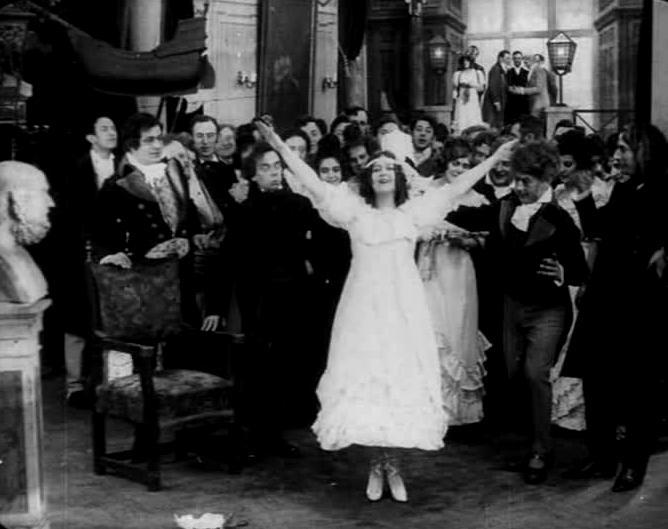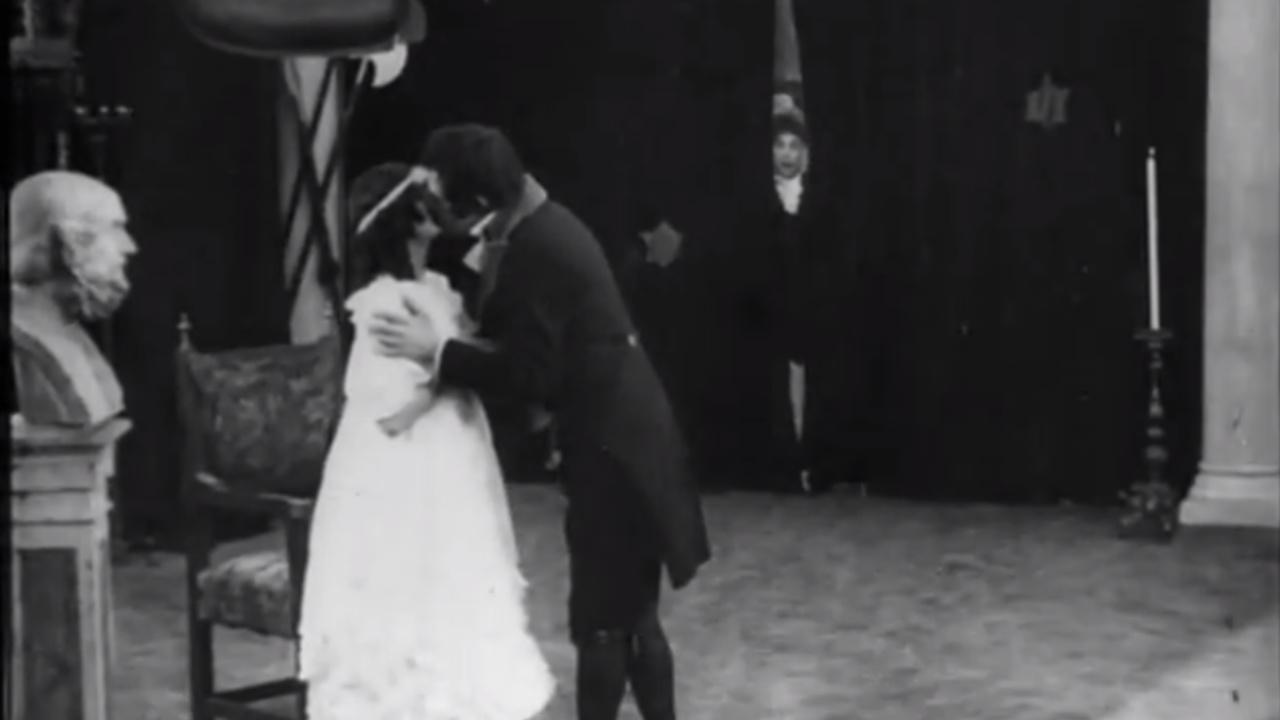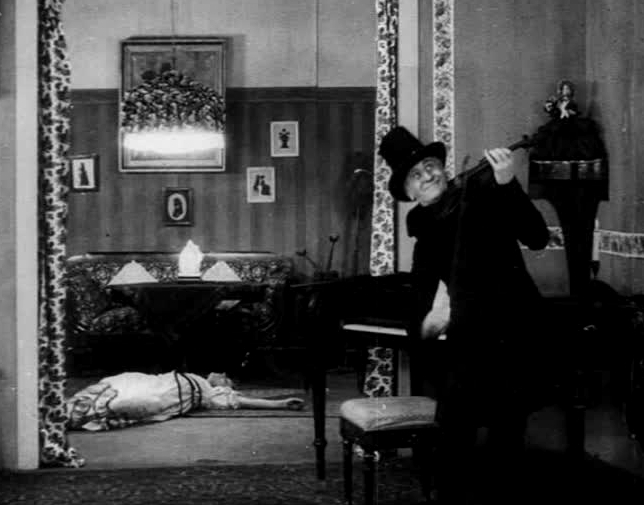ESTA CRÍTICA
CONTÉM SPOILERS
THIS ARTICLE
HAS SPOILERS
De acordo com o dicionário Oxford, o
termo robô foi originado nos anos 1920, em uma peça tcheca chamada “R.U.R
Rossum’s Universal Robots”, vindo da palavra tcheca robota, que significa
trabalho forçado. O filme “Hoffmanns Erzählungen”, ou “Contos de Hoffmann”, foi
feito antes de 1920, mas tem um robô - ou melhor, um autômato. Robô e
autômato são sinônimos até hoje.
According to the Oxford Dictionary, the term robot
was originated in the 1920s, coming from a Czech play called “R.U.R Rossum’s
Universal Robots”, and came from the Czech word robota, meaning forced labor.
The film “Hoffmanns Erzählungen”, or “Tales of Hoffmann” was made before 1920,
but it has a robot - or better, an automaton. Robot and automaton are used as
synonyms until now.
No Prelúdio, conhecemos o jovem E.T.A
Hoffmann (Kurt Wolowsky), que mora com o tio e o enfurece com seu hábito de
desenhar caricaturas. Perto da casa de Hoffmann podemos encontrar os
alquimistas Coppelius (Friedrich Kühne) e Spalanzani (Lupu Pick) que, como bons
alquimistas, querem produzir ouro, mas a partir de partes do corpo humano. Um
dia, Hoffmann fica de castigo por causa de uma caricatura que ele desenhou do
Conde Dapertutto (Werner Krauss), mas o jovem escapa e encontra o esconderijo
dos alquimistas, e lá fica horrorizado com as experiências deles. Hoffmann
desmaia na rua e é salvo por uma dançarina chamada Angela (Relly Ridon), uma
mulher casada cobiçada por um médico. Depois que Hoffmann se recupera, Angela
morre subitamente depois de uma última dança.
In the Prelude, we get to know the young E.T.A.
Hoffmann (Kurt Wolowsky), who lives with his uncle and enrages him with his
habit of drawing caricatures. Near Hoffmann’s place we can find the alchemists
Coppelius (Friedrich Kühne) and Spalanzani (Lupu Pick) who, as good alchemists,
want to make gold, but out of people’s body parts. One day, Hoffmann is
grounded because of a caricature he drew of Count Dapertutto (Werner Krauss)
but the young man escapes and finds the alchemists’ place, where he gets
horrified with their experience. Hoffmann collapses in the street and is saved
by a dancer named Angela (Relly Ridon), a married woman coveted by a doctor.
After Hoffman recovers, Angela dies suddenly after a last dance.
Quando começa o Primeiro Ato,
encontramos Hoffmann já como homem maduro - agora interpretado por Erich
Kaiser-Titz - e amante da atriz Stella (Kathe Oswald). Quando o noivo de Stella
flagra os dois, Hoffmann foge. Em uma pequena cidade, ele encontra Coppelius e
Spalanzani, agora um vendedor de óculos e um diretor de museu, com a mais nova
invenção deles: Olympia (Alice Hechy), um autômato quase real. Ao usar os
óculos especiais e mágicos de Coppelius, Hoffmann se apaixona por Olympia,
acreditando que ela é uma mulher real, mas ele tem seu coração partido ao tirar
os óculos.
When the First Act begins, we find Hoffmann as a
mature man - now played by Erich Kaiser-Titz - and the lover of actress Stella
(Kathe Oswald). When Stella’s fiancé find the two, Hoffmann escapes. In a small
town, he meets Coppelius and Spalanzani, now a glass seller and a museum
director, with their newest invention: Olympia (Alice Hechy), a life-like
automaton. While wearing Coppelius’s special magical glasses, Hoffmann falls in
love with Olympia, believing she is a real girl, only to have his heart broken
when the glasses are removed.
Então, para esquecer Olympia,
Hoffmann vai ao teatro e se apaixona pela rica Giulietta (Thea Sandten) - que
está mais interessada em seus pretendentes viciados em jogo. De volta ao lar,
Hoffmann namora Antonia, a filha de Angela - a mulher que o ajudou muitos anos
antes - que foi proibida pelo pai de dançar e que também é cortejada pelo
médico que cobiçava sua mãe, o vingativo doutor Miracle (Andreas von Horn).
Then, to forget Olympia, Hoffmann goes to the
theater and falls for the rich Giulietta (Thea Sandten) - who is more
interested in her gambling suitors. Back home, Hoffmann dates Antonia, the
daughter of Angela - the woman who helped Hoffmann many years before - who is
forbidden to dance by her father and who is also courted by the doctor who
courted her mother, the revengeful doctor Miracle (Andreas von Horn).
E.T.A. Hoffmann realmente existiu:
ele foi um autor de literatura fantástica do século XVIII e início do século
XIX. “Os Contos de Hoffmann” são uma coletânea dos contos dele em forma de
ópera, composta por Offenbach em 1881. Para o filme de 1916, os roteiristas -
uma dupla que incluía o diretor Richard Oswald - mudaram a ordem dos atos da
ópera.
E.T.A. Hoffman really existed: he was a writer of
fantastic literature from the 18th and early 19th centuries. “The Tales of
Hoffmann” is a collection of his stories in the shape of an opera, composed by
Offenbach in 1881. For the 1916 film, the screenwriters - a duo that included director
Richard Oswald - changed the order of the acts of the opera to film.
A história do autômato é
interessante, mas muito curta - dura cerca de 15 minutos. O filme alemão “A Boneca”, de 1919, por outro lado, traz uma história de amor com autômato maior
e melhor. Algo a se notar em “Contos de Hoffmann” é o uso de efeitos especiais
para mostrar o autômato, em versão miniatura, girando dentro de uma caixa. Não
encontrei detalhes sobre como isso foi feito, mas uma cena semelhante aparece
em “A Noiva de Frankenstein” (1935), com miniaturas se mexendo dentro de
garrafas. No filme de Hollywood, o efeito foi obtido quando se colocaram os
atores em jarras gigantescas em frente a um veludo preto, e a cena gravada foi
editada junto aos atores interpretando os cientistas.
The automaton story is interesting, but very short
- it lasts about 15 minutes. The German film “The Doll”, from 1919, on the
other hand, has a nicer and longer automaton love story. The one thing to
notice in “Tales of Hoffmann” is the use of special effects to show Olympia the
automaton, in a miniature version, moving inside a box. I couldn’t find how it
was made, but a similar scene appears in “The Bride of Frankenstein” (1935),
with miniatures moving in bottles. In this Hollywood film, the effect was
achieved by putting the actors in huge jars in front of black velvet then
mixing and lining up this footage with the footage of the scientists.
Fica óbvio que o banqueiro Elias, um
personagem menor, é judeu - algo que depois é inclusive mencionado e confirmado
em uma carta. Muitos judeus trabalhavam com finanças, na Alemanha e no resto do
mundo, e há a ideia geral de que judeus têm talento para os negócios. Uma das
razões para a perseguição de judeus na era nazista foi o ressentimento em
relação à banqueiros judeus que, diretamente ou não, teriam ajudado na derrota da
Alemanha na Primeira Guerra Mundial.
It’s clear to the eyes - and later stated in a letter
- that the banker Elias, a minor character, is a Jew. Many Jews worked in the
financial field, in German and elsewhere, and there is the general idea that
Jews have a talent for business. One of the reasons for the persecution of Jews
during the Nazi era was the bitterness towards Jewish bankers who, directly or
indirectly, might have helped Germany to be defeated in World War I.
Os belos cenários em cenas de
interiores são a melhor coisa de “Contos de Hoffmann” - um filme sobre um homem
que não consegue ser feliz no amor. A versão que temos disponível, com 67
minutos, é considerada incompleta pelo site silentera.com, mas não há quase
nada faltando e as histórias podem ser compreendidas sem problemas. Servindo
mais como uma curiosidade e uma experiência, “Contos de Hoffmann” é para os
mais loucos cinéfilos e os mais audaciosos aventureiros do cinema.
The gorgeous interior sets are the best thing about
“Tales of Hoffmann” - a film about a man who can’t find happiness in his love
life. The print we have available now, with 67 minutes, is considered
incomplete by the site silentera.com, but there isn’t much missing and the
stories can be understood perfectly. Serving as more of a curiosity and an
experience, “Tales of Hoffmann” is for the craziest cinephiles and the most
daring screen adventurers.
This is my contribution to the Robots in Film blogathon,
hosted by Quiggy and Hamlette at The Midnight Drive-In and Hamlette’s Soliloquy.







3 comments:
Great review! I've always wanted to see this version, as I'm a fan of the opera, and I love cinematic versions of operas. I will see if I can find this to watch!
How intriguing! I knew vaguely that Tales of Hoffmann was about a guy who has a bunch of failed love-affairs, but I didn't know that it involved animated dolls and gold made out of dead people! Very intriguing. Did the version you watch have music from Offenbach's opera for the background?
Thanks for joining the blogathon!
Quite a fascinating selection. I was unaware of this version of Tales of Hoffmann until now. Fascinating how they switched up the acts to tell their story. I'll be checking this out when I can.
Post a Comment